| It looked like a marine version
of the Joad’s exodus in the Grapes of Wrath. On top of
the van was my son Alan’s Elegant Punt, Creamsicle. Behind
the van was my Chebacco Wayward Lass, and stuffed inside
Wayward Lass was my daughter Lindsay’s canoe, recently
renamed Que Sera. (This canoe is a cedar strip rendition
of Rushton’s Sairey Gamp, only nine feet long and weighing
almost nothing.) Lindsay and Alan themselves followed
the boat trailer in Maureen’s (my wife’s) Toyota. We were
on our way to Schooner Cove Marina, the jumping off point
for South Winchelsea Island, owned by The Land Conservancy,
a non-profit outfit dedicated to preserving land that
might otherwise be developed and lost to public enjoyment.
The Winchelsea Islands are only about two miles south
of Schooner Cove and about a mile from the shore of Vancouver
Island. Schooner cove itself is just a few miles north
of Nanaimo, also on Vancouver Island.
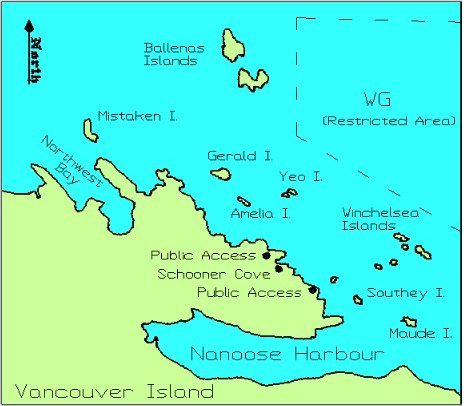
We arrived at the marina, after picking
up Joan and Jim, old friends from Calgary, at the Nanaimo
ferry terminal. Half of us went to look for Lyle, our
Land Conservancy contact, while the rest started unloading
gear and getting Wayward Lass ready for launching. By
the time we’d got the mast up and the halyards untangled,
our food and bags were transferred to the Land Conservancy
boat, and we were set to launch Wayward Lass and go.
Except it was low tide, and the bottom of the launch
ramp had a covering of sand and gravel, making it impossible
to get deep enough to float or push Wayward Lass off
her trailer. (We don’t have rollers, just carpet covered
bunks.) Things looked awkward until Lyle came to the
rescue with a stout towline and some 100 horses. A burst
of throttle and Wayward Lass was afloat!
Again, we split up, half the gang going in the powerboat,
and half in Wayward Lass. A short time later, we were
all together again at our island retreat, getting settled
in. Pretty nice cabin – big living room, three bedrooms
and an attic room, indoor plumbing, a propane fired
stovetop and fridge. Downright palatial, really. Even
Wayward Lass was well looked after, with a good solid
dock, and the loan of some serious fenders to keep her
off it. These were much appreciated, as the lower edge
of the dock was high enough for Wayward Lass to catch
her sheer under it as she moved – her own fenders might
not have been enough to do the job.
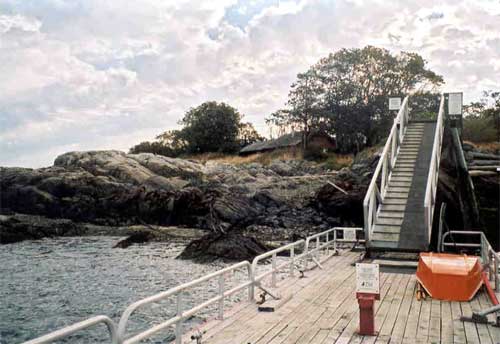
A view of the cabin, from our
dock
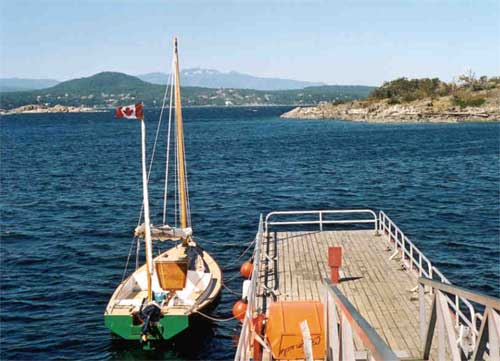
Wayward Lass and Creamsicle
Although the dock is in a somewhat
sheltered bay between the north and south islands, the
full width of Georgia Strait was just a few steps away,
across a rocky spit. There was a good wind blowing,
and waves were crashing on those rocks, with lots of
spray and noise. We all headed over to that side, checking
out the pools for crabs and small fish. Lindsay suddenly
announced that she’d seen a snake in one of the pools.
We thought at first that it must have been some kind
of eel, but after we waited a few minutes, sure enough
a snake’s head rose up from the weeds at the bottom
of the pool and broke the surface. The snake stayed
quite still, only its tongue flickering as it caught
its breath. Then it disappeared as quietly. It came
up again for air several times while we watched, occasionally
in a different place, but we never saw it moving around
the bottom because of the weeds. Finally it swam to
the edge of the pool and glided off through the rocks,
towards the grass and bushes. This was all new to us,
but since then we’ve been told it’s not unusual for
snakes to hunt for their dinner along the shore.
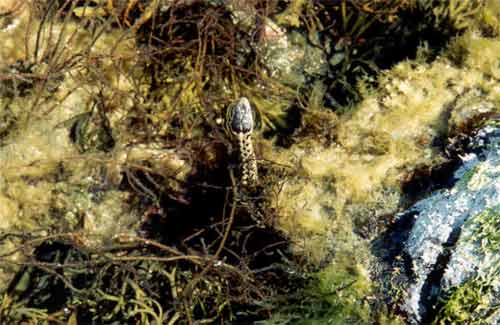
Rear view of snake in the water
I mentioned that we had Lindsay’s
little double paddle canoe, Que Sera, with us. After
our sail, Lindsay took it out to explore the edges of
the bay, while Alan and I rowed Creamsicle to keep her
company. We raced up the gap between North Winchelsea
Island and an unnamed island close beside it, to the
bay where the navy have a large dock. I was rowing,
and could just beat Lindsay in the sprints, but she
had the advantage over the long haul. She also went
more easily through the narrow channel – our oars just
barely made it between the sides. We said hello to a
harbour seal, then rowed and drifted back to the bay.
Lindsay turned off for a quick swim at what we called
our beach, a strip of pulverized shells that was clear
of the water at low tide, and covered completely at
high. For an hour or two in the middle of each tide,
it looked like a real beach, lying between two rocky
outcrops.
The next morning, several of us piled
into Wayward Lass for a sail. The wind was strong, so
we tied in both reefs before casting off. We used the
motor to get away from the dock, since there was a rocky
shore immediately downwind, but shut it off as soon
as the sails caught the wind. Once we cleared our “home”
bay, the wind blew harder and the waves were higher,
but we only took an occasional bit of spray aboard.
We headed north, beating up between the Winchelsea Islands
and a group of smaller islands and large rocks, not
really going anywhere, just enjoying being out. We had
a good view of the military installation on the north
island – the islands are just inside an area known as
Area Whiskey Golf, where the Canadian and US navies
play torpedo games (without the warheads!) We continued
on around the north end of the island, then ran down
the east side, finally turning west and north again,
back to our bay. This was a good shake-down outing,
giving a couple of our less experienced sailors a feel
for what they could expect.
Once we were back, it was time to sail Creamsicle. Before
doing anything else, I tied a reef in her sail, re-lacing
the sail lower on the mast. Then we slid her over the
rails, and dropped the mast, with the sail set, into
its step. The rudder went on next, after some fiddling
(later we found it was easier to launch with the rudder
already in place) and finally the leeboard. Lindsay,
who is (was) a non-sailor, and I went out first. I handled
the sheet, and Lindsay sat in the back with the tiller.
We had no problem getting moving, and went back and
forth across the bay, at maybe three knots, but with
a bow wave good enough for six!
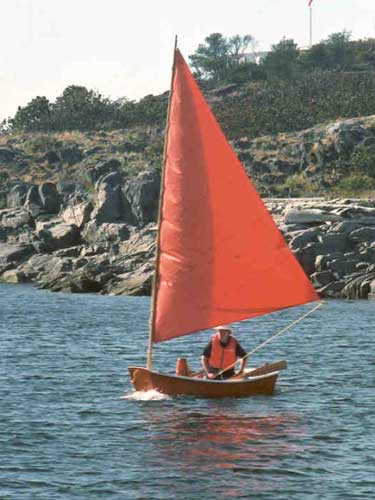
Jim in Creamsicle, without
the reef
After that, Lindsay went looking for
her brother, and the two of them went out. They made
a load that was well matched to the hull – my 225 pounds
are really too much to share the boat with anyone else.
Together the kids weigh less than that! They were pretty
excited, so much so that they were two hundred yards
away before I realized they’d left their PFDs behind.
I motored out in Wayward Lass with the PFDs, and took
the opportunity to get a picture or two. I was really
quite impressed with the way the elegant punt carried
the two of them – we haven’t used the punt much since
the sail was finished. Lindsay is seventeen now, and
Alan fourteen, but both are pretty slim. Together they
probably weigh 200 pounds, but more importantly they
were able to balance each other nicely.
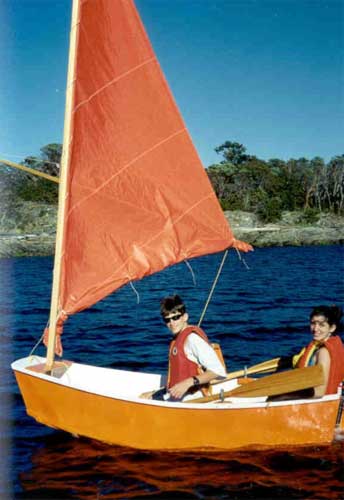
Alan and Lindsay in Creamsicle,
with a reef in the sail
The highlight of the day was seeing,
up close, a baby seal. Joan was sitting on the rocks
by the shore when she noticed a very small seal on a
bit of gravel below her. Most of the time it lay very
still, but as the water rose, it had to climb higher
up and that was probably what caught Joan’s eye. Soon
it had six pairs of eyes watching its every move, and
was looking a little nervous. However, once we all found
seats and stopped moving so much, it appeared to calm
down and accept our company. We watched each other for
quite a while, until the rising tide finally covered
the strip of gravel, and the little seal swam off.
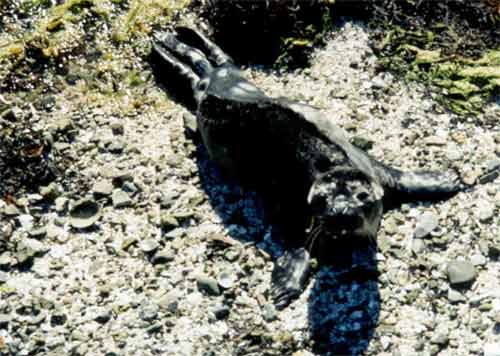
Baby Seal
We think it must have been left there
to wait while its mother went off to catch herself some
dinner.
On Tuesday, the kids wanted to stay
at the cabin, so only the four adults went off in Wayward
Lass. We set off, this time on a reach with no reefs,
towards Nanoose Bay, a mile away and almost directly
west of us. It’s a couple of miles deep, and fairly
narrow in comparison. It’s also sheltered from most
of the northwest wind. It didn’t take long to get well
into the bay, or to reach our goal, a small marina on
the south shore. The marina, whose name I’ve forgotten,
was in pretty rough shape – many of the docks looked
like they’d been damaged by storms, and only a few boats
were tied up there. However, we went ashore and managed
to find a small store a few hundred yards away, where
we bought some ice creams – the real reason for coming
here!
Going home, as we reached the point at the end of the
bay the wind was stronger, and our island was now somewhat
to windward. A reef was in order, so as usual, I centred
the mizzen, and let the mainsheet run. This normally
keeps us head to wind, but for some reason it didn’t
work this time. I think that having four adults in the
cockpit must have cocked up the bow, which made it catch
the wind more than usual. In any case, we used the motor
to keep us into the wind while I reefed – at least with
all those bodies aboard, there were lots of extra hands.
Once reefed, we had a good sail back to the island,
passing several rocky islets that are home to dozens
of birds and seals.
Docking at the island was always interesting. On the
first day, under power, I managed to ram the dock –
gently, but still not a satisfactory landing. After
that, every landing but the last was done under sail,
and there was no more ramming, nor any missed landings.
The dock stuck out at ninety degrees from the shore,
and for our week at least, the wind was blowing almost
directly onto shore. Since the shore was rocky, we had
to make our approach at less than ninety degrees to
the dock, turning sharply into the wind to finish alongside.
I have to admit I never finished right beside the dock,
but always about two feet away. At first I thought I
was turning too early, but later I wondered if it might
be due to the sharp turn. Even with the bow almost touching
at the start of the turn, we would pivot on the centreboard,
which was still 10 or 12 feet away from the dock. In
any case, we always had to step across the last two
feet.
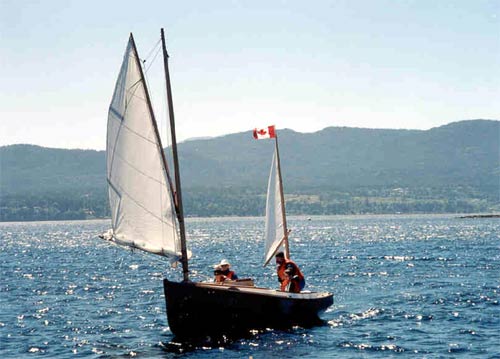
Coming in to dock, two reefs
in the main
The wind increased on Tuesday afternoon,
so Jim, Lindsay and I went out to see how Wayward Lass
sailed under jib and mizzen, or jib and jigger as the
old timers might have said. As I’ve commented elsewhere,
the jib on a Chebacco really needs a bowsprit to get
it away from the mainsail, but we didn’t plan to use
the main at all. I think the wind was about 25 knots
when we went out. We found the jib and jigger worked
fine, making 5 knots across the wind. We didn’t go to
windward very well, though I think we might have beaten
off a lee shore if given enough time and enough room
for very wide tacks.
By late afternoon, the forecast was
upgraded to a storm warning, with winds of 44 knots
or better. Just before we sat down to dinner, I was
looking over to the Vancouver Island side, and saw a
small powerboat plunging into the waves, now a good
bit bigger and showing a lot of white. I was glad it
wasn’t me out there, but they seemed to be making steady
headway towards Schooner Cove, another two miles to
windward.
A few minutes later, we looked out and saw a small (16
foot) boat heading into our bay, and went down to give
them a hand docking. Sure enough it was the same boat
I’d seen a few minutes earlier. They’d been out fishing,
and had left it too late to get home – they thought
they’d be all right, but after a couple of waves came
right over the bows, they decided to turn and run for
Winchelsea. Luckily they had a foredeck with a windshield
and a bit of cabintop, otherwise they could (would?)
have been swamped. We offered some dinner and somewhere
to sleep, but they said no thanks, they’d eaten and
they’d be fine down on the dock – they did accept some
sleeping bags, though, and some fenders and mooring
ropes. They were asleep when I went down to check on
Wayward Lass at 2:00 am, so I guess it wasn’t too bad.
Next morning it was still blowing hard, but the storm
was over and the forecast said it would improve further
by lunchtime. It hadn’t rained at all and the whole
week was warm, even at night. Our “guests” wanted to
get on their way, and we wanted to get over to Schooner
Cove as well, as Lindsay had arranged to stay with a
friend in Victoria for the second half of the week.
We agreed that conditions had improved enough by 11:00
am, and both boats set off. The power boat quickly left
us behind, our 5 horses had their work cut out just
to keep us plugging away into the wind – we didn’t try
to sail as Schooner Cove was dead to windward. We were
making maybe half the speed we would normally manage
on the same throttle setting. By the time we got in,
Jim, Lindsay and I were all soaked by the spray, but
at least Lindsay was able to change before she started
her drive.
After seeing Lindsay safely away, we thought we’d run
under the jib alone on the way back to the island. The
wind was still dropping, and we could have used the
main instead, but wanted to experiment. It was quite
successful, with an estimated 20 knots of wind we managed
3 knots downwind under the jib alone, and 4 under jib
and mizzen. We also tried out my latest gadget, a bright
red plastic foghorn, to alert our wives that we were
coming in, and wanted someone to photograph the boat
in this rig. The horn worked like a charm, so I’m able
to show you a picture here!
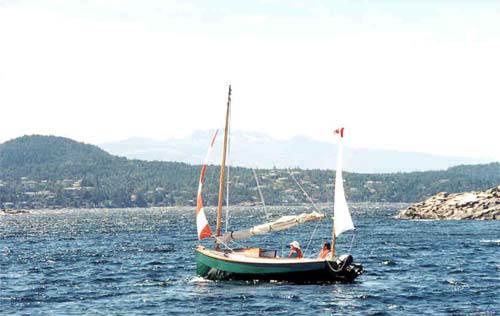
Under jib and jigger
On Thursday, we were down to a small
craft warning, and that not until the late afternoon,
so we planned something a little more ambitious, a trip
to the Ballenas Islands, about 4 miles to windward.
We had a good sail, making most of the distance on one
tack, and turned into a large protected bay between
the islands. It was about time for some lunch, so we
headed downwind to a long curving beach. It was a lee
shore, but we had good protection from the wind and
waves. We dropped the anchor about 100 yards from shore,
and let out a lot of rode, drifting back towards the
beach. Tying a line to the inflatable, we could get
two people ashore at once, then pull it back for the
next load.
We had a good lunch, then hiked around a bit. The beach
was made up of tiny stones, about ¼ inch around, and
polished smooth – very hard to walk on as we lost half
a step for every one taken. Behind the beach, we found
some fruit trees from an old settlement attempt, with
pears and apples on the branches, but they weren’t ripe
yet. Once back on the beach we buried Alan in the tiny
stones, then Jim and I went for a swim. We’d forgotten
our suits, so we just went along the beach a ways, and
stripped off. Our wives were laughing at us and taking
pictures (the camera was out of film, so you can keep
reading) while Alan did his “These are my parents.”
routine. It’s tough being a teenager – just as well
the camera was empty.
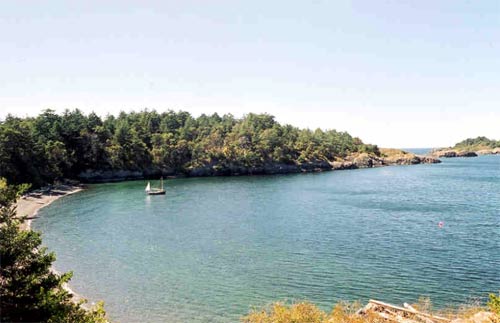
At anchor at Ballenas
The trip back to Winchelsea was a
treat, running before a good breeze. It was over in
no time at all, and everyone agreed we’d had a great
day.
Friday was our last full day. The wind was light, although
there was another small craft warning for the late afternoon.
We were pretty familiar with our own island by now,
and since we’d all enjoyed the day before, we thought
we’d try repeating it with another island. The only
new candidate less than 10 miles away was nearby Maude
Island, at the mouth of Nanoose Bay. Only a mile, but
the chart showed it had an interesting indentation at
the south end.
The chart was right on. The indentation turned out to
be a narrow cove with steep rocky sides, leading back
to a gravel beach. Jim stood on the bow to guide me
as we motored in, as there were lots of rocks below
the surface. Once in, the bottom was smooth gravel.
We dropped the anchor in five feet of water, and Alan
rowed me ashore in Creamsicle (which we’d towed over)
with the other end of the line for a stern tie to keep
Wayward Lass off the sides.
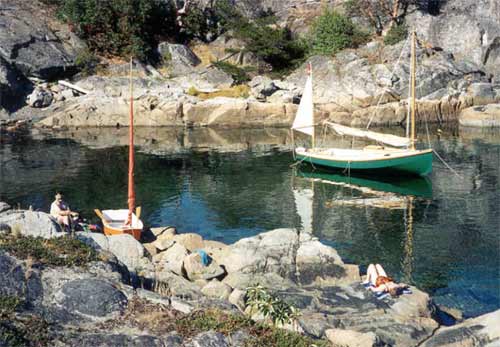
In the cove at Maude Island
It was a perfect anchorage for the
day – completely sheltered from the wind, and open to
the sun. When it got too hot, there was shade by some
large rocky bluffs. There were two pairs of mother and
baby seals on the outer rocks – we could see them quite
well, but didn’t get any good pictures. We lazed around,
ate, swam – the usual stuff. I had a good look at Wayward
Lass’ bottom then swam down to the anchor – I love the
cruising guides that tell you to do this to make sure
it’s properly set. I’d like to see the writers do this
around Victoria! We were able to swim here because the
water gets noticeably warmer as you go north in Georgia
Strait, supposedly because the tide doesn’t bring in
the cold Pacific currents every day.
We finally packed up and headed back
to our own island. On the way we had our only mutiny,
caused not by rough weather, but by too nice weather.
We were half sailing, half drifting quietly along when
the mutineers, led by the captain’s wife, demanded that
we start the motor so we could get home to our dinner.
The captain, not being stupid, promptly started the
motor.
And that’s about it. Saturday was going-away day, so
in the morning we cleaned up the cabin and packed the
gear. The Land Conservancy was sending out a boat at
12:30, but I knew it would take some time to recover
Wayward Lass and get everything ready for the road,
so Alan and I left at 11:30 for Schooner Cove. We arrived
about 12:00, and both of us were busy for the next hour
and something. I was just finishing the last job, lashing
the Creamsicle on top of the van, when we saw the others
coming in.
Altogether, it was a great holiday, and South Winchelsea
is a great base for small boat sailing. If anyone would
like to know more about it, or about The Land Conservancy,
go to https://www.conservancy.bc.ca
, or email me, Jamie, at jorr@bcauditor.com.

Wayward Lass in the afternoon
sun – my “artistic” photograph
|

